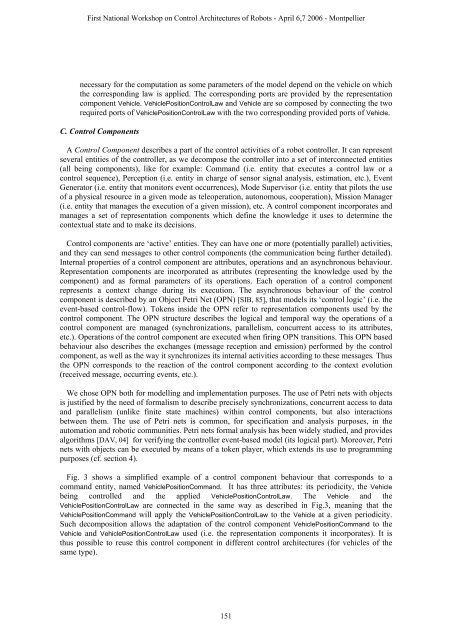Pleading for open modular architectures - Lirmm
Pleading for open modular architectures - Lirmm
Pleading for open modular architectures - Lirmm
You also want an ePaper? Increase the reach of your titles
YUMPU automatically turns print PDFs into web optimized ePapers that Google loves.
First National Workshop on Control Architectures of Robots - April 6,7 2006 - Montpellier<br />
necessary <strong>for</strong> the computation as some parameters of the model depend on the vehicle on which<br />
the corresponding law is applied. The corresponding ports are provided by the representation<br />
component Vehicle. VehiclePositionControlLaw and Vehicle are so composed by connecting the two<br />
required ports of VehiclePositionControlLaw with the two corresponding provided ports of Vehicle.<br />
C. Control Components<br />
A Control Component describes a part of the control activities of a robot controller. It can represent<br />
several entities of the controller, as we decompose the controller into a set of interconnected entities<br />
(all being components), like <strong>for</strong> example: Command (i.e. entity that executes a control law or a<br />
control sequence), Perception (i.e. entity in charge of sensor signal analysis, estimation, etc.), Event<br />
Generator (i.e. entity that monitors event occurrences), Mode Supervisor (i.e. entity that pilots the use<br />
of a physical resource in a given mode as teleoperation, autonomous, cooperation), Mission Manager<br />
(i.e. entity that manages the execution of a given mission), etc. A control component incorporates and<br />
manages a set of representation components which define the knowledge it uses to determine the<br />
contextual state and to make its decisions.<br />
Control components are ‘active’ entities. They can have one or more (potentially parallel) activities,<br />
and they can send messages to other control components (the communication being further detailed).<br />
Internal properties of a control component are attributes, operations and an asynchronous behaviour.<br />
Representation components are incorporated as attributes (representing the knowledge used by the<br />
component) and as <strong>for</strong>mal parameters of its operations. Each operation of a control component<br />
represents a context change during its execution. The asynchronous behaviour of the control<br />
component is described by an Object Petri Net (OPN) [SIB, 85], that models its ‘control logic’ (i.e. the<br />
event-based control-flow). Tokens inside the OPN refer to representation components used by the<br />
control component. The OPN structure describes the logical and temporal way the operations of a<br />
control component are managed (synchronizations, parallelism, concurrent access to its attributes,<br />
etc.). Operations of the control component are executed when firing OPN transitions. This OPN based<br />
behaviour also describes the exchanges (message reception and emission) per<strong>for</strong>med by the control<br />
component, as well as the way it synchronizes its internal activities according to these messages. Thus<br />
the OPN corresponds to the reaction of the control component according to the context evolution<br />
(received message, occurring events, etc.).<br />
We chose OPN both <strong>for</strong> modelling and implementation purposes. The use of Petri nets with objects<br />
is justified by the need of <strong>for</strong>malism to describe precisely synchronizations, concurrent access to data<br />
and parallelism (unlike finite state machines) within control components, but also interactions<br />
between them. The use of Petri nets is common, <strong>for</strong> specification and analysis purposes, in the<br />
automation and robotic communities. Petri nets <strong>for</strong>mal analysis has been widely studied, and provides<br />
algorithms [DAV, 04] <strong>for</strong> verifying the controller event-based model (its logical part). Moreover, Petri<br />
nets with objects can be executed by means of a token player, which extends its use to programming<br />
purposes (cf. section 4).<br />
Fig. 3 shows a simplified example of a control component behaviour that corresponds to a<br />
command entity, named VehiclePositionCommand. It has three attributes: its periodicity, the Vehicle<br />
being controlled and the applied VehiclePositionControlLaw. The Vehicle and the<br />
VehiclePositionControlLaw are connected in the same way as described in Fig.3, meaning that the<br />
VehiclePositionCommand will apply the VehiclePositionControlLaw to the Vehicle at a given periodicity.<br />
Such decomposition allows the adaptation of the control component VehiclePositionCommand to the<br />
Vehicle and VehiclePositionControlLaw used (i.e. the representation components it incorporates). It is<br />
thus possible to reuse this control component in different control <strong>architectures</strong> (<strong>for</strong> vehicles of the<br />
same type).<br />
151

















